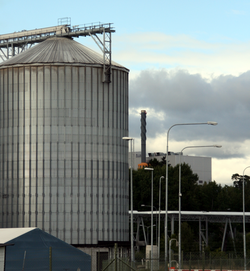Eco-industrial park

An eco-industrial park (EIP) is an
The Eco-industrial Park Handbook[2] states that "An Eco-Industrial Park is a community of manufacturing and service businesses located together on a common property. Members seek enhanced environmental, economic, and social performance through collaboration in managing environmental and resource issues."
Based on the concepts of
EIPs can be developed as greenfield land projects, where the eco-industrial intent is present throughout the planning, design and site construction phases, or developed through retrofits and new strategies in existing industrial developments.
Examples

"
The industrial symbiosis at Kalundborg was not created as a top-down initiative, but instead evolved gradually. As environmental regulations became stricter, firms were motivated reduce the cost of compliance, and turn their by-products into economic products.
In Canada, eco-industrial parks exist across the country and have enjoyed some success. The best known example is Burnside Park, in Halifax, Nova Scotia. With support from Dalhousie University’s Eco-Efficiency Centre,[4] the more than 1,500 businesses have been improving their environmental performance and developing profitable partnerships. Subsequently, two greenfield industrial developments have been started in Alberta: TaigaNova Eco-Industrial Park[5] is in the heart of the Athabasca oil sands, while Innovista Eco-Industrial Park[6] is a gateway to the Rocky Mountains ~300 km west of Edmonton.
UNIDO Viet Nam (United Nations Industrial Development Organization) has compiled a list in 2015 of Eco-Industrial Parks (EIP) in the ASEAN Economic Community in a report titled "Economic Zones in the ASEAN Archived 2020-09-30 at the Wayback Machine" written by Arnault Morisson.
Other usage
EIPs also refer to industrial parks where a "green" approach has been taken towards the infrastructure and development of the site. This can include green infrastructure related to Renewable Energy Systems; stormwater, groundwater and wastewater management; road surfaces; and transportation demand management. Green building practices can also be encouraged or mandated
EIPs are often used as a stimulus for economic diversification in the community or region where they are located. Anchor tenants, such as bio-based product manufacturers or waste-to-energy facilities, etc., can attract complementary businesses as suppliers, scavengers/recyclers, service providers, downstream users and other businesses that could benefit from eco-industrial strategies.
Suggested usage
It is suggested that EIPs be used as a means of growing the renewable energy sector. In the case of a Solar Photovoltaic (PV) Manufacturing plant, an EIP can increase the manufacturing efficiency to make it more economical, while reducing the environmental impact of producing the solar cells. In essence, this assists the growth of the renewable energy industry and the environmental benefits that come with replacing fossil-fuels.[7]
See also
- EcoPark – EIP in Hong-Kong
- Industrial ecology
- Industrial symbiosis
References
- ^ AM Hein, M Jankovic, R Farel, B Yannou 2015. A Conceptual Framework For Eco-Industrial Parks. Proceedings of the ASME 2015 International Design Engineering Technical Conferences & Computers and Information in Engineering Conference IDETC/CIE 2015
- ^ Lowe, Ernest A. 2001. Eco-industrial Park Handbook for Asian Developing Countries. A Report to Asian Development Bank, Environment Department, Indigo Development, Oakland, CA
- ^ J. Ehrenfeld and N. Gertler(1997), "Industrial Ecology in Practice. The Evolution of Interdependence at Kalundborg",Journal of Industrial Ecology, 1:1, pp 67–79
- ^ "Eco‑Efficiency Centre". Dalhousie University. Archived from the original on 2012-02-08. Retrieved 2009-03-06.
- ^ http://www.taiganova.com Archived 2008-12-06 at the Wayback Machine
- ^ http://www.eip.hinton.ca Archived 2009-06-08 at the Wayback Machine
- ^ J. M. Pearce, Industrial Symbiosis for Very Large Scale Photovoltaic Manufacturing, Renewable Energy 33, pp. 1101-1108, 2008,[1]
- Industrial Location in Greece: Fostering Green Transition and Synergies between Industrial and Spatial Planning Policies by Anestis Gourgiotis, Stella Sofia Kyvelou and Ioannis Lainas, Land 2021, 10(3), 271; – 6 March 2021
Further reading
- Greening the Asphalt Acres. Alberta Venture. Aug, 2008.[permanent dead link]
- Eco-industrial Zones: Sustaining the wealth of industrial developments. Building Sustainable Communities E-Zine. Jan, 2009.[permanent dead link]
- Eco-Industrial Parks surging in popularity. Business Edge Magazine. Nov, 2008.
- https://www.unido.org/fileadmin/user_media_upgrade/Resources/Publications/UCO_Viet_Nam_Study_FINAL.pdf Archived 2020-09-30 at the Wayback Machine Economic Zones in ASEAN. UNIDO. 2015.
External links
- Industrial Symbiosis
- Industrial Ecology Wiki - Repository of information about Eco-Industrial Parks around the world
- Indigo Development Eco-Industrial Park page and handbook
- Existing and Developing Eco-Industrial Park Sites in the U.S.
- Industrial Symbiosis Timeline
- Industrial Symbiosis in Action
- Zero Emissions Research & Initiatives
- TaigaNova Eco-Industrial Park in Fort McMurray, AB, Canada
- Innovista Eco-Industrial Park in Hinton, AB, Canada
- CleanTech Park in Singapore
- European EIPs/EEPAs
- [2]Infinity Industrial Park
